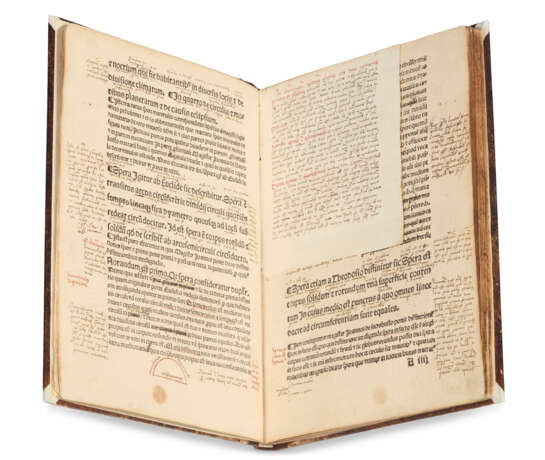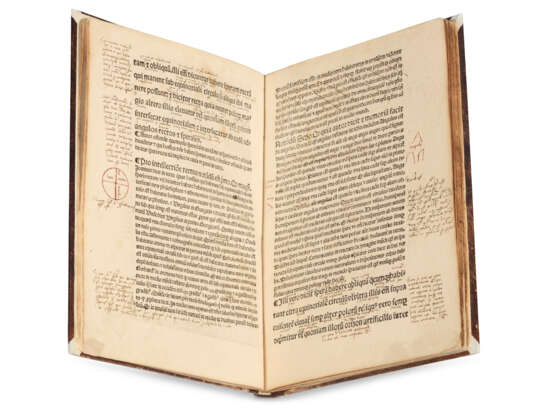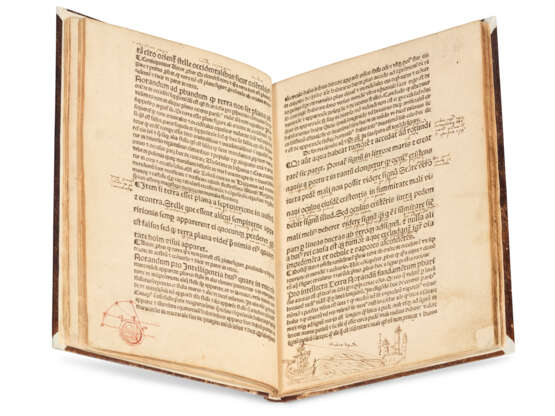ID 1360812
Lot 96 | Introductorium compendiosum in tractatum spere
Valeur estimée
$ 8 000 – 12 000
The first Americanum printed in Poland; rare second edition with extensive contemporary annotations and sketches. Glogoviensis taught at the University of Krakow from 1468 until his death in 1507, overlapping with and possibly teaching a young Nicolaus Copernicus. One year before his death, he completed this present commentary on Sacro Bosco’s Sphaera. The edition reprints Regiomontanus’s solar declination table and features many astronomical woodcuts as well as a full-page geocentric model of the heavens.
The work contains a rare reference to the discovery of the New World, not recorded by Sabin or Harrisse. Glogoviensis refers to Vespucci’s (putative) expeditions of 1501 and 1504 on the verso of leaf g2. Refuting Sacrobosco’s assertion that the torrid zones between the two tropics and the area beyond the Arctic circle are uninhabitable due to the extreme temperatures, Glogoviensis cites the island of Trapobana (Ceylon), which is situated on the equator and yet densely populated, and continues: "And the same thing is confirmed by those who in the year 1501 and similarly in the year 1504 were sent by the King of Portugal to discover the origin of pepper and other aromatic spices. They sailed beyond the equator and saw both celestial hemispheres and their stars and they found the origin of pepper in a place which they called the New World which was hitherto unknown.”
An early reader of this copy has written extensive notes and annotations throughout the text, at times even striking blocks of printed text. In Sacro Bosco's section on the Earth's spherical nature and specifically the shape of water, the reader has drawn out a neat visualization of the experiment that Sacro Bosco relates to demonstrate that the surface of the sea is curved: "Set a signal on the coast and let a ship sail away so far from the port that the eye of a person standing at the foot of the mast can no longer see the signal. If the ship is stopped and the person climbs to the top of the mast, he will see the signal clearly. A person at the foot of the mast ought to see the signal better than the person at the top, as shown by drawing straight lines to the signal from both positions. And there is no other explanation of this thing than the swelling of the water." In addition to annotating this passage of text, the reader draws out the port, the signal, the ship, the mast with one person at its foot and one in its crow's nest and the two straight lines over the bulging sea between them. This very active reader has also gone so far as to interleave a half-page sheet into one of the quires, which is covered in neat manuscript additions, inserting extra space for their own thoughts on Sacro Bosco's opus. Alden-Landis 513/8; Bibliographia Polonica 22; not in Houzeau-Lancaster.
Quarto (205 × 157mm). Full-page woodcut armillary sphere, additional woodcut diagrams (light soiling and occasional stains, few leaves with corners repaired). Modern quarter calf, spine gilt (light scratches). Provenance: extensive contemporary marginalia and added leaves – Owen Gingerich (bookplate).
| Adresse de l'enchère |
CHRISTIE'S 20 Rockefeller Plaza 10020 New York Etats-Unis | ||||||||||||||
|---|---|---|---|---|---|---|---|---|---|---|---|---|---|---|---|
| Aperçu |
| ||||||||||||||
| Téléphone | +1 212 636 2000 | ||||||||||||||
| Fax | +1 212 636 4930 | ||||||||||||||
| Conditions d'utilisation | Conditions d'utilisation | ||||||||||||||
| transport |
Service postal Service de messagerie ramassage par vous-même | ||||||||||||||
| Modes de paiement |
Virement bancaire | ||||||||||||||
| Heures d'ouverture | Heures d'ouverture
|





